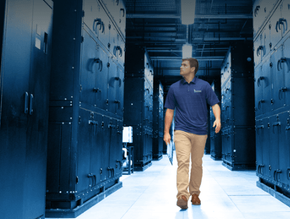Temperature and humidity control in data centres

Vaisala is a global leader in weather, environmental, and industrial measurements, and Munters is a global leader in energy efficient and sustainable climate control solutions for mission-critical processes, including data centres.
In Part 1, we look at data centre energy efficiency
In Part 2, we look at temperature & humidity control
In Part 3, we look at the importance of accurate measurements
Containment and energy efficiency
One of the primary considerations for energy efficiency in air-cooled data centre cooling is hot aisle/ cold aisle containment. Sadly, containment is still poorly managed in many legacy data centres, leading to low energy efficiency. New data centre builds, on the other hand, tend to take containment very seriously, which contributes significantly to the performance.
For many, supply air temperatures are optimally between 24 and 25.5°C (75.2 and 77.9°F). However, delta-T is very important - the temperature differential between the hot aisle and the cold aisle. Typically, delta-T is around 10 to 12°C (18 to 21.6°F), but 14°C (25.2°F) is a common objective in data centre design. Increasing delta-T results in dual benefit of reducing the fan motor energy use required by the cooling systems, as well as increasing the potential for economising heat rejection strategies.
Economisation is the process by which outdoor air can be utilised to facilitate a portion of data centre heat rejection. Economisation can occur directly, where outdoor air is actually brought into the cooling systems and delivered to the servers (after appropriate air filtration), or indirectly, where recirculating data centre air is rejected to ambient by way of an air-to-air heat exchanger.
This lowers costs and improves efficiency and sustainability. However, to maintain efficiency, air side pressure drops, due to filtration, should be minimised. So, if air is recirculated within the data centre, without the introduction of outside air, it should be possible to reduce or eliminate the need for filtration altogether.
Cooling and ventilation require careful control, and it is important to deploy high efficiency fans, maintain a slight positive building pressure, and to control room humidity. For example, make-up air systems should control space dew point sufficiently low such that cooling coils only undertake sensible cooling, without having to tackle a latent load (removal of moisture from the air).
The overall objective of the heat rejection system is to maintain optimal conditions for the IT equipment, whilst minimising energy usage. Low humidity, for example, can increase the risk of static electricity, and high humidity can cause condensation, which is a threat to electrical and metallic equipment; increasing the risk of failure and reducing the working lifetime. High humidity levels combined with various ambient pollutants have been shown to accelerate corrosion of various components within servers.
Cooling is essential to remove the heat generated by IT equipment; to avoid over-heating and prevent failures. According to some studies, a rapidly fluctuating temperature can actually be more harmful for the IT devices than a stable higher temperature, so the control loop is important from that perspective.
The latest IT equipment is typically able to operate at higher temperatures, which means that the intake temperature can be raised and the potential for free cooling and economisation is improved. Outdoor air can be utilised to cool indoor air either directly or indirectly (as noted above), and evaporative or adiabatic cooling can further improve the efficiency of economisation.
These energy saving technologies have been extensively deployed, with the trend being towards dry heat rejection strategies that consume no water. As the temperature of the heat extraction medium (air or liquid) rises, the potential for waste heat from data centres to be effectively used increases, allowing for example, its use in district heating networks. In Helsinki, for example, Microsoft and the energy group Fortum are collaborating on a project to capture excess heat. The data centre will use 100% emission-free electricity, and Fortum will transfer the clean heat from the server cooling process to homes, services and business premises that are connected to its district heating system. This data centre waste heat recycling facility is likely to be the largest of its kind in the world.






